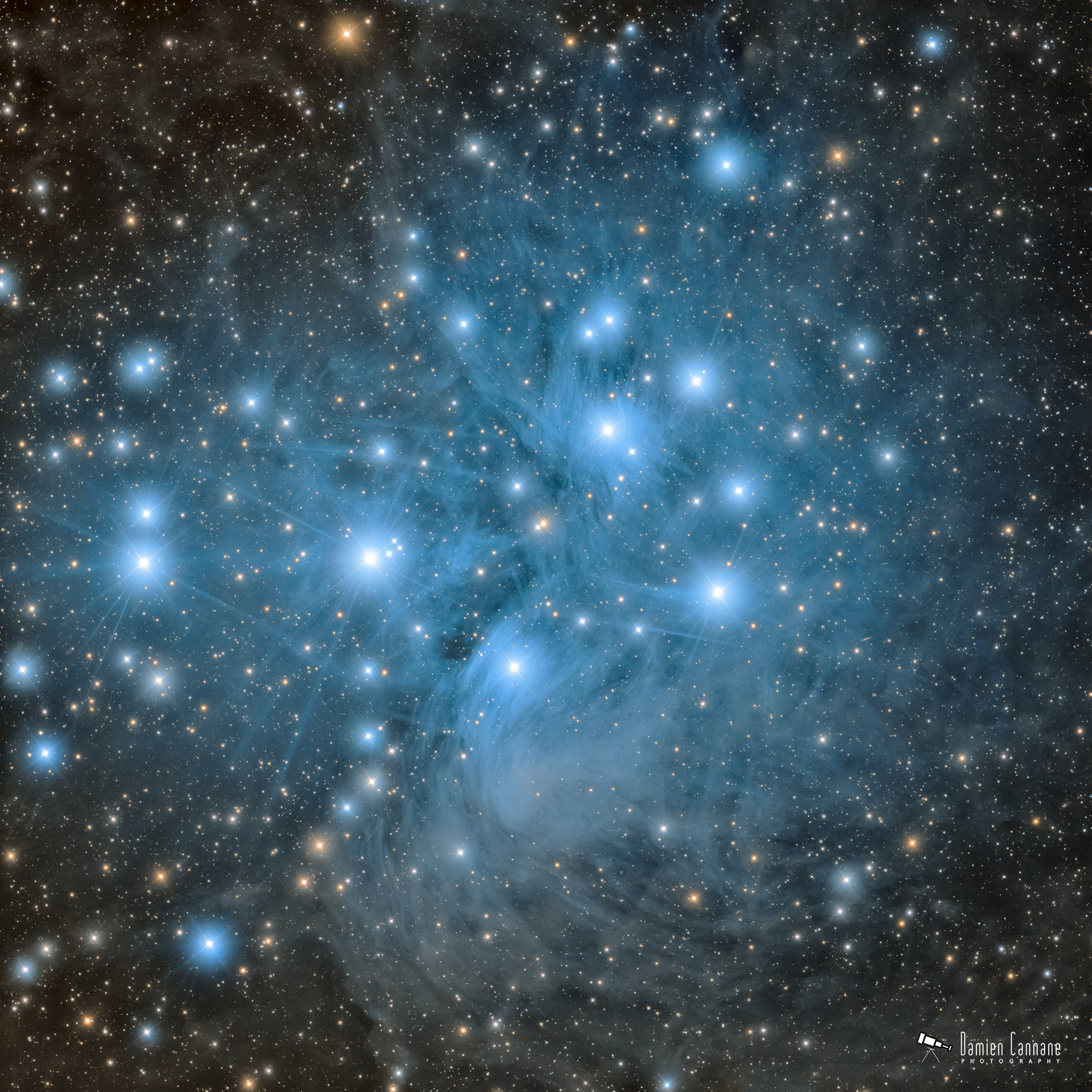
Posted on 11/25/2021 3:48:48 AM PST by MtnClimber
Explanation: Have you ever seen the Pleiades star cluster? Even if you have, you probably have never seen it as large and clear as this. Perhaps the most famous star cluster on the sky, the bright stars of the Pleiades can be seen without binoculars from even the depths of a light-polluted city. With a long exposure from a dark location, though, the dust cloud surrounding the Pleiades star cluster becomes very evident. The featured exposure, taken from Florida, USA, covers a sky area several times the size of the full moon. Also known as the Seven Sisters and M45, the Pleiades lies about 400 light years away toward the constellation of the Bull (Taurus). A common legend with a modern twist is that one of the brighter stars faded since the cluster was named, leaving only six of the sister stars visible to the unaided eye. The actual number of Pleiades stars visible, however, may be more or less than seven, depending on the darkness of the surrounding sky and the clarity of the observer's eyesight.
(Excerpt) Read more at apod.nasa.gov ...
For more detail go to the link and click on the image for a high definition image. You can then move the magnifying glass cursor then click to zoom in and click again to zoom out. When zoomed in you can scan by moving the side bars on the bottom and right side of the image.

Another one that displays electromagnetic plasma affecting those bodies.
Many people think this is the Little Dipper, since the observable stars, six for most people, look like a very small dipper and handle.
Stunning.........
The cluster core radius is about 8 light-years and tidal radius is about 43 light-years. The cluster contains over 1,000 statistically confirmed members, a figure that excludes an unresolved likely further number of binary stars.[47] Its light is dominated by young, hot blue stars, up to 14 of which can be seen with the naked eye depending on local observing conditions and visual acuity of the observer. The arrangement of the brightest stars is somewhat similar to Ursa Major and Ursa Minor. The total mass contained in the cluster is estimated to be about 800 solar masses and is dominated by fainter and redder stars.[47]
The cluster contains many brown dwarfs, which are objects with less than about 8% of the Sun’s mass, not heavy enough for nuclear fusion reactions to start in their cores and become proper stars. They may constitute up to 25% of the total population of the cluster, although they contribute less than 2% of the total mass.[48] Astronomers have made great efforts to find and analyse brown dwarfs in the Pleiades and other young clusters, because they are still relatively bright and observable, while brown dwarfs in older clusters have faded and are much more difficult to study.
I have been able to see 10 or 11 stars in the Pleiades on exceptionally clear nights, far from any city lights.
Even in moderate light pollution, it’s easy to spot if one knows where to look.
The Pleadies is one of my favorites, I love showing it to people at star parties, especially kids.
Subaru owners, check out the logo on your vehicles, it’s the Seven Sisters.
Subaru is the Japanese name.
🔭
Yes, you can see the Pleiades in less-than-perfect viewing conditions, but you won’t see as many stars. By the way, the Subaru logo has six stars.

Thanks for posting that!
Pleiades was the first star cluster I looked at when I got my telescope, a Newtonian reflector with a 5” mirror. It was TRANSFORMING !
I don’t own a Subaru, I wish I did🙂
Growing up in Northern Minnesota, the Dippers dominate the long dark winter nights. I, too, first called it the Little Dipper. I learned quite early, though, that the North Star forms the end of the handle of the Little Dipper, and that the two stars forming the end of the Big Dipper point to the North Star. The "Tiny Dipper" was not part of this group. The Little Dipper is harder to see than the big Dipper because of its size and the dimness of some of its stars. The Pleiades (I didn't learn the name until much later) were easier to see. Even, for a short while, in my young inexperience, I thought I was the first to discover this "Tiny Dipper".
I had a GL wagon for quite a while, nice little car. Bought it for $1200 around 1995 with 100K miles, and put another 120K on it before selling it for $1000 in 2004. The second owner after me rolled it the day after he got it.
Stunning!
Blue stars burn hot, and die early.
It’ll forever be the kitty dipper now, up in the sky over the silo.
They like to hide those pet photos in the hot links! Astronomer humor!
Disclaimer: Opinions posted on Free Republic are those of the individual posters and do not necessarily represent the opinion of Free Republic or its management. All materials posted herein are protected by copyright law and the exemption for fair use of copyrighted works.